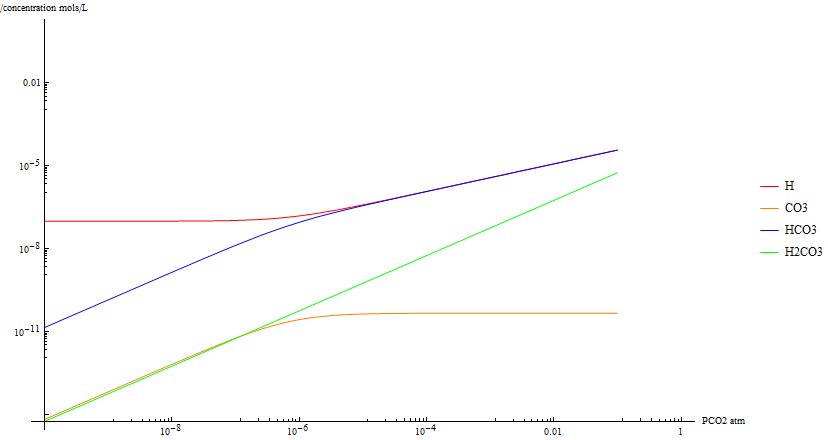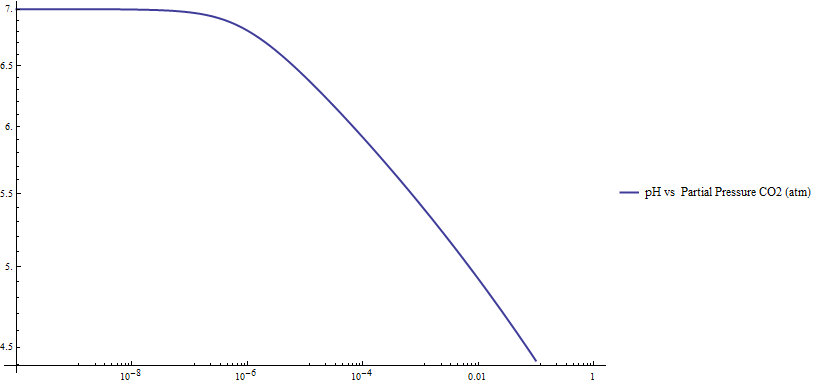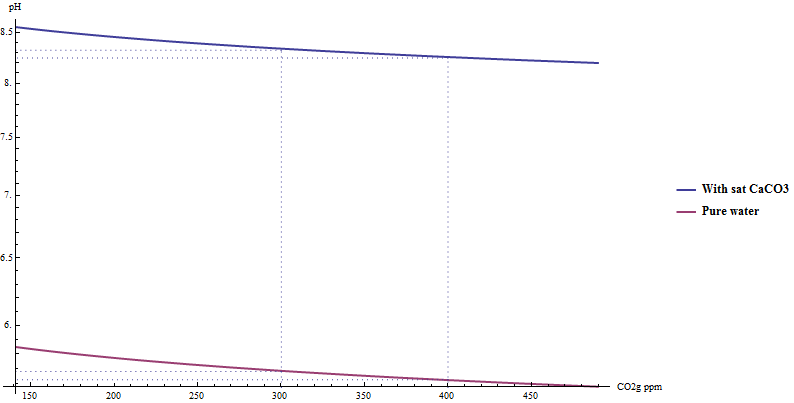![]() and pH
and pH
CO2 in pure water
Start with pure water in equilbrium with carbon dioxide gas at partial pressure ![]() . Henry’s law determines the amount of
. Henry’s law determines the amount of ![]() disolved in the water:
disolved in the water:
![]()
The dissolved ![]() combines with the water in a series of reaction with the following equilbrium constants. (In everything that follows,
combines with the water in a series of reaction with the following equilbrium constants. (In everything that follows, ![]() is taken to mean
is taken to mean ![]() dissolved). )
dissolved). )
![]()
![]()
![]()
![]()
In addition to these equilbrium equations, there is a charge neutrality condition:
![]()
Equations 1-6 are six equations for the unknowns in terms of the ![]() --Once the partial pressure is established concentrations of the six quantities are determined. They arre easily solved numerically by way of Mathematica or other software. Here is the concentration of the four species as a function of the
--Once the partial pressure is established concentrations of the six quantities are determined. They arre easily solved numerically by way of Mathematica or other software. Here is the concentration of the four species as a function of the ![]() partial presuure in units of atmosphere:
partial presuure in units of atmosphere:

Figure 1. CO2 dissolved in Pure Water-Concentration of components vs CO2 partial pressure(atm)
Here is chart of pH as function of CO2 partial pressure:

Figure 2. CO2 dissolved in Pure Water--pH vs. partial pressure CO2(atm)
Note the pH is always less then 7.0. The pH is about 5.6 at ![]() concentration 380ppm; about the same as pure rainwater. Fresh water in lakes and streams acquires dissolved Calcium. The Calcium in the form of Calcium Carbonate raises the pH, as we see in the next section.
concentration 380ppm; about the same as pure rainwater. Fresh water in lakes and streams acquires dissolved Calcium. The Calcium in the form of Calcium Carbonate raises the pH, as we see in the next section.
Water with Calcium
Calcium carbonate is slightly soluble in water. From the Solubility Product value,
we obtain a solubility less than 3 milligrams per liter. This minute amount of Calcium makes a huge change in pH however. Assume the amount Calcium Caarbonate is at saturation level, include equation 7 into equations 1-6. get the following solutions:

Figure 3. CO2 dissolved in Pure Water Saturated with ![]() --Concentration of components vs CO2 partial pressure(atm)
--Concentration of components vs CO2 partial pressure(atm)
Here is plot of pH vs ![]() concentration for pure water and water saturated with
concentration for pure water and water saturated with ![]() ;
;

Figure 4. pH of wate with and without dissolved Ca; Horizontal units in ![]() atm)
atm)
The pH of about 8.3 is experimentally observed for water saturated with ![]() and exposed to air. In nature, fresh water pH is lower:typicaly ranging 6.5 to 7.5. There are two reasons for this reduced pH : (1)
and exposed to air. In nature, fresh water pH is lower:typicaly ranging 6.5 to 7.5. There are two reasons for this reduced pH : (1) ![]() is not at saturation levels and (2) other ions sulfates for example will lower this pH. In the laboratory, pure water exposed to air and saturated with both
is not at saturation levels and (2) other ions sulfates for example will lower this pH. In the laboratory, pure water exposed to air and saturated with both ![]() and Gypsum
and Gypsum ![]() ) is observed to have pH 7.75. The attached calculation sheet shows how to calculate this value.
) is observed to have pH 7.75. The attached calculation sheet shows how to calculate this value.
Next: Ocean pH